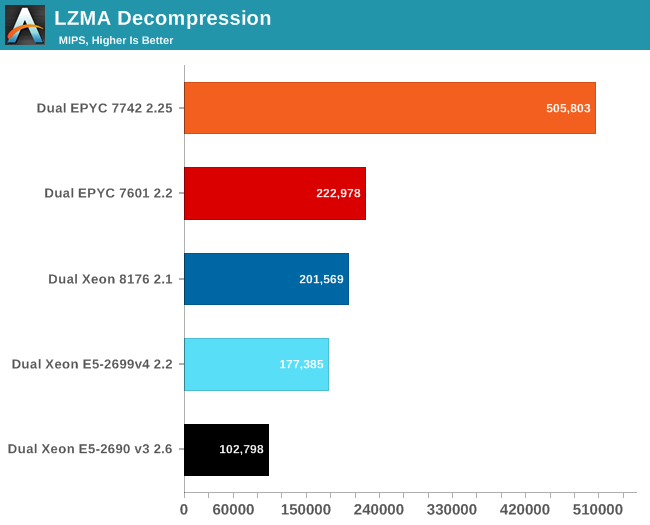AMD Rome Second Generation EPYC Review: 2x 64-core Benchmarked
by Johan De Gelas on August 7, 2019 7:00 PM ESTLegacy: 7-zip
While standalone compression and decompression are not real world benchmarks (at least as far as servers go), servers have to perform these tasks as part of a larger role (e.g. database compression, website optimization). With that said, we suggest you take these benchmarks with a large grain of salt, as they are not really important in grand scheme of things. We still use 7zip 9.2, so you can compare with much older results.

Compression on modern cores relies almost solely on cache, memory latency, and TLB efficiency. This is definitely not the ideal situation for AMD's EPYC CPU, but the EPYC 7742 scales very well, offering 77% higher performance than Naples. That is better than expected scaling.

Decompression relies on less common integer instructions (shift, multiply). AMD's Zen2 core handles these instructions even better because doubling the cores results in no less than 127% (!) better performance.
Even though this benchmark is not that important, it is nevertheless impressive how AMD engineering made this graph look. Never have we seen AMD dominating benchmarks by such a wide margin.
Before people accuse us of choosing a benchmark that shows AMD in the best light, consider this benchmark as one of our synthetic tests more than anything else, designed to showcase core execution port potential. It is not really indicative of any real-world performance, but acts as a synthetic for those that have requested this data.










180 Comments
View All Comments
Kevin G - Wednesday, August 7, 2019 - link
Clock speeds. AMD is being very aggressive on clocks here but the Ryzen 3000 series were still higher. I would expect new Threadripper chips to clock closer to their Ryzen 3000 cousins.AMD *might* differentiate Threadripper by cache amounts. While the CPU cores work, they may end up binning Threadripper based upon the amount of cache that wouldn't pass memory tests.
Last thing would be price. The low end Epyc chips are not that expensive but suffer from low cores/low clocks. Threadripper can offer more for those prices.
quorm - Wednesday, August 7, 2019 - link
Here's hoping we see a 16 core threadripper with a 4ghz base clock.azfacea - Wednesday, August 7, 2019 - link
half memory channels. half pcie lanes. also i think with epyc AMD spends more on support and system development. i can see 48c 64c threadripper coming 30-40% lower and not affecting epyctwtech - Wednesday, August 7, 2019 - link
If they gimp the memory access again, it mostly defeats the purpose of TR as a workstation chip. You'd want an Epyc anyway.quorm - Wednesday, August 7, 2019 - link
Well, on the plus side, the i/o die should solve the asymmetric memory access problem.ikjadoon - Wednesday, August 7, 2019 - link
Stunning.aryonoco - Wednesday, August 7, 2019 - link
Between 50% to 100% higher performance while costing between 40% to 50% less. Stunning!I remember the sad days of Opteron in 2012 and 2013. If you'd told me that by the end of the decade AMD would be in this position, I'd have wanted to know what you're on.
Everyone at AMD deserves a massive cheer, from the technical and engineering team all the way to Lisa Su, who is redefining what "execution" means.
Also thanks for the testing Johan, I can imagine testing this server at home with Europe's recent heatwave would have not been fun. Good to see you writing frequently for AT again, and looking forward to more of your real world benchmarks.
twtech - Wednesday, August 7, 2019 - link
It's as much about Intel having dropped the ball over the past few years as it is about AMD's execution.According to Intel's old roadmaps, they ought to be transitioning past 10nm on to 7nm by now, and AMD's recent releases in that environment would have seemed far less impressive.
deltaFx2 - Wednesday, August 7, 2019 - link
Yeah, except I don't remember anyone saying Intel was going great guns because AMD dropped the ball in the bulldozer era. AMD had great bulldozer roadmaps too, it didn't matter much. If bulldozer had met its design targets maybe Nehalem would not be as impressive... See, nobody ever says that. It's almost like if AMD is doing well, it's not because they did a good job but intel screwed up.Roadmaps are cheap. Anyone can cobble together a powerpoint slide.
Lord of the Bored - Thursday, August 8, 2019 - link
Well, it is a little of both on both sides.Intel's been doing really well in part because AMD bet hard on Bulldozer and it didn't pay out.
Similarly, when AMD's made really good processors but Intel was on their game, it didn't much matter. The Athlon and the P2/3 traded blows in the Megahertz wars, but in the end AMD couldn't actually break Intel because Intel made crooked business deals*backspace* because AMD was great, but not actually BETTER.
The Athlon 64 was legendary because AMD was at the top of their game and Intel was riding THEIR Bulldozer into the ground at the same time. If the Pentium Mobile hadn't existed, thus delaying a Netburst replacement, things would be very different right now.